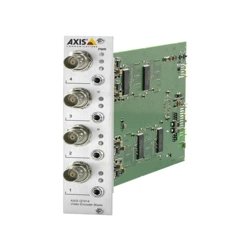Loading ...
Loading ...
Loading ...

37
AXIS Q7414 - System Options
One-click enabled - Press the video encoder blade’s control button (see Overview, on page 5) to connect to an AVHS service
over the Internet. Once registered the video encoder blade stays connected to the AVHS service. If the video encoder blade is
not registered within 24 hours after the button is pressed, the video encoder blade will disconnect from the AVHS service.
Always - The video encoder blade will co
nstantly attempt to connect to the AVHS service over the Internet. Once registered
the video encoder blade will stay connected to the service. This option can be used when the video encoder blade is already
installed and it is not convenient to use the one-click installation.
AXIS Internet Dynamic DNS Service - U
se the AXIS Internet Dynamic DNS service to assign a host name for easy access to
your video encoder blade (requires Internet access).
Click Se
ttings... to register the video encoder blade with the Axis Internet Dynamic DNS service, or to modify the existing
settings (requires access to the Internet). The domain name currently registered at the Axis Internet Dynamic DNS service for
your product can at any time be removed.
For more information, please refer to the online help
.
Advanced TCP/IP Settings
DNS Configuration - DNS (Domain Name Service) provides the translation of host names to IP addresses on your network.
Obtain DNS server address via DHCP - aut
omatically use the DNS server settings provided by the DHCP server. Click the View
button to see the current settings.
Use the following DNS server address - enter t
he desired DNS server by specifying the following:
• Domain name - enter
the domain(s) to search for the host name used by the video encoders. Multiple domains can
be separated by semicolons (;). The host name is always the first part of a Fully Qualified Domain Name, for
example, myserver is the host name in the Fully Qualified Domain Name myserver.mycompany.com where
mycompany.com is the Domain name.
• DNS servers - enter th
e IP addresses of the primary, and secondary DNS servers.
Note:
A secondary DNS server is not mandatory.
NTP Configuration - Obtain NTP server address via DHCP - select this radio button option to automatically look up and
use the NTP server settings as provided by DHCP. Click the View button to see the current settings.
Use the following NTP server address - to c
reate manual settings, check this radio button and enter the host name or IP
address of the NTP server.
Host Name Configuration - The video encoders can be accessed using a host name, instead of an IP address. The host
name is usually the same as the assigned DNS Name.
For more information, please see Security, on page
34.
Link-Local IPv4 Address - This is enabled by default and assigns the video encoders an additional IP address for use with
UPnP
™. The video encoder blade can have both a Link-Local IP and a static/DHCP-supplied IP address at the same time -
these will not affect each other.
HTTP and HTTPS - The default HTTP/HTTPS port numbers (80 and 443 respectively) can be changed to any port within the
range 1024-65535. This is useful for simple security port mapping, for example.
NAT traversal (port mapping) for IPv4 - A broadband router allows devices on a private network (LAN) to share a single
connection to the Internet. This is done by forwarding network traffic from the private network to the “outside”, that is, the
Internet. Security on the private network (LAN) is increased since most broadband routers are pre-configured to stop attempts
to access the private network (LAN) from the public network/Internet.
Loading ...
Loading ...
Loading ...
